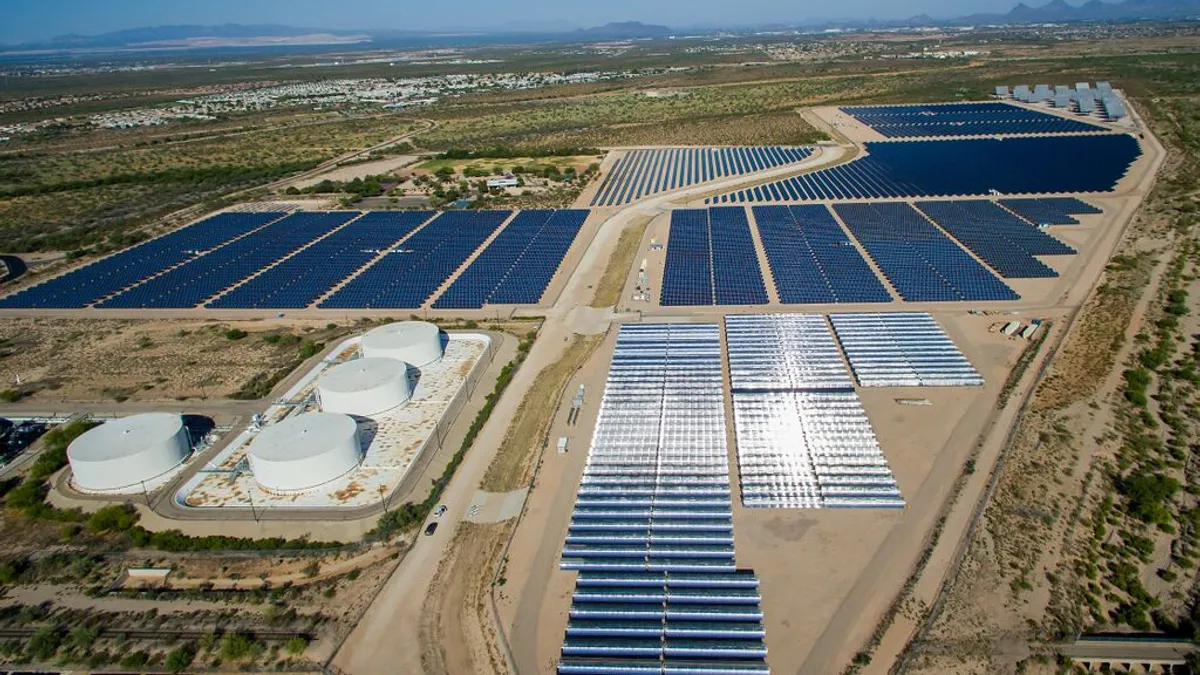The power purchase agreement Tucson Electric Power signed with NextEra Energy for an “all-in cost significantly less than $0.045/kWh over 20 years” has become the new benchmark for combining solar power with energy storage, but at least one industry expert says the math is not as simple as it seems.
According to Tucson Electric, the 100 MW solar portion of the project came in at under $0.03/kWh, putting the 30 MW, 120 MWh energy storage piece in the ballpark of $0.015/kWh.
“Just because you’re being paid 4.5 cents, doesn’t mean the system costs 4.5 cents,” James Lazar, senior advisor at the Regulatory Assistance Project in Olympia, Wash., told Utility Dive in an interview.
Lazar assumes the 100 MW solar system in Arizona produces electricity for 10 hours a day and yields 1,000 MWh a day of energy. But the batteries store only 120 MWh or 12% of the solar output.
Lazar then takes the difference between the cost with storage and the cost without storage, i.e., 1.5 cents, and divides it by the percentage of energy stored, in other words, 12%. The result is 1.5 cents divided by 12% which comes out to $0.125/kWh. When you add in a 20% discount for round-trip efficiency losses, the total cost comes to roughly $0.13/kWh. “That is still a good deal,” says Lazar, but it is not $0.015/kWh.
The utility is still paying $0.045/kWh over the life of the contract, but “it is deceptive to call it $0.015/kWh. You have to look at what you are getting,” Lazar said.
In Lazar’s analysis, the Tucson Electric PPA does not set a new benchmark for low cost solar-plus-storage projects, though it is cheaper than two other recent projects in Kauai, Hawaii.
In one, Kauai Island Utility Cooperative is paying AES Corp. $0.11/kWh for a 28 MW solar array with a 20 MW, 100 MWh battery system. In the other, Tesla signed a $0.14/kWh PPA with the same utility for a 13 MW solar project tied to a 13 MW, 52 MWh battery system.
In both of those deals, the storage component of the combined system is more closely sized to the solar portion of the project. Applying his same analysis, Lazar comes up with a $0.17/KWh for the storage portion of the Tesla deal and $0.12/kWh for the storage portion of the AES deal. Discounted for round trip efficiency, that comes to $0.19/kWh for the Tesla deal and $0.13/kWh for the AES deal.
Lazar also points out that the costs and benefits of a project are locational. For an island system like Kauai, the solar-plus-storage projects are a good deal because they are still lower than the cost of generating power using diesel fuel, the mainstay of Hawaii’s conventional generating fleet. Those deals will definitely reduce consumers’ costs on Kauai, he said.
The Tucson Electric PPA “may be a good deal,” Lazar said. It falls in the range between on-peak and off-peak power prices and when viewed as an alternative to gas-fired peaking resources, it is becoming competitive. “This is a sea change for the industry,” he said.
Ravi Manghani, director of energy storage at GTM Research, agrees with Lazar that the storage component of the Tucson Electric project is undersized. When looking at any of these recent deals, “you have to be careful about how you apply them as benchmarks,” he told Utility Dive in an interview. GTM uses two metrics: the ratio of storage to the system and a comparison of the total energy output of both components.
Comparisons that use a single number to measure storage can be misleading, Manghani said. But “we are seeing specific examples of storage looking at competing with natural gas-fired peaking plants,” he said. Those comparison often are with fully depreciated gas peakers, but in a comparison between two greenfield projects, solar-plus-storage could be competitive, he added.
Correction: An earlier version of this article incorrectly stated James Lazar's calculations of the cost of solar plus storage systems.














